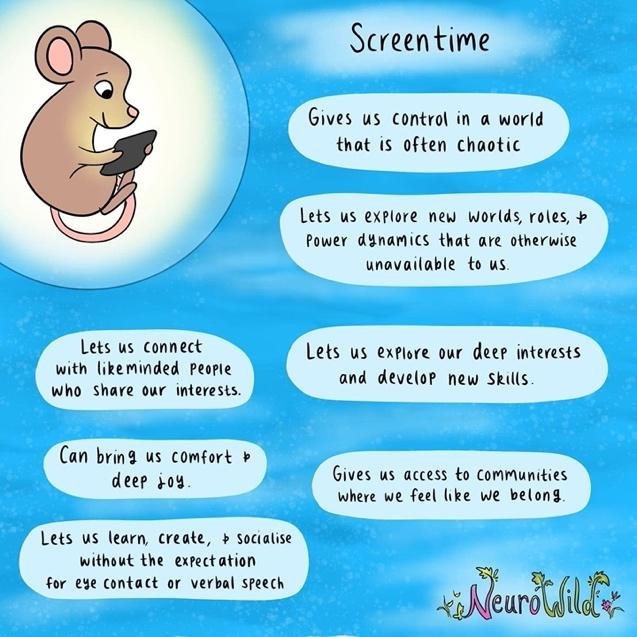Autism and Screen Time
By Yeji Jo
As the world becomes increasingly shaped by digital technology, the topic of screen time and its impact on Autistic individuals, including those with a Pathological Demand Avoidant (PDA) profile, has become a largely discussed topic.
At The Kidd Clinic, parents often ask us about the optimal level of screen use. The role of screen time varies greatly for Autistic and PDA individuals. It is important to obtain a thorough understanding of how many demands are being placed on the young person and to what extent screen time is being used as a regulation tool. This blog outlines some questions and considerations to keep in mind as you think about your Autistic individual’s screen use.
It is also important to consider your Autistic young person’s neurodivergence and unique way of experiencing the world. Contemplating the following questions with a neuroaffirming perspective is essential.
How can screens be utilised as a self-regulation tool?
Screens can provide access to a controlled and predictable environment. A break from the chaotic and intense real world. Intense world theory proposes that some Autistic brains and sensory systems are supercharged. It suggests that neurodivergent brains experience sensations and the environment much more intensely than neurotypical brains.
Screens can be part of a special interest! It is helpful to reframe what some may think as “inflexible” or “obsessive” as “special interests” or “passions”. The drive to engage with a special interest is deep and powerful. It is naturally motivating, calming, and rewarding.
Interacting via screens can facilitate friendships. Is online communication and interaction filling your individual’s social cup? They may also be engaging in parasocial relationships. Parasocial relationships are one-sided relationships formed with fictional characters. These relationships can provide connection, corrective emotional experiences, and permission to express oneself more fully.
Parents – here are some questions to ask yourself:
There is no right or wrong answer here. Reflecting on your difficulties may aid in collaboratively and empathically working with your individual around screen time.
What specifically about screen time are you struggling with? Is it a particular game/website, hyperfixation, or amount of screen time? It is important to break down your concerns and consider whether they are realistic or manageable expectations for the individual. Does the young person have the skills or capacity to meet your expectations?
What is it about screen time your individual enjoys? What stimulation are they receiving from it? How can you provide that stimulation elsewhere (other competing activities)?
How is your individual utilising screen time to de-stress? Is it a particular game? Are they learning about an interest? Sometimes mindless web surfing is a great way to de-stress as there are little to no demands or pressures involved.
What part of your expectation is your individual struggling with? Many parents ask for help with transitioning their young person from the screen to an activity that is of less interest. The PDA Space talks about the different types of transitions that are important to consider here.
What are you, as parents, modelling? Think about your own screen time and how your child is perceiving this. Are you talking out loud about the difficulties you have limiting your screen time and how you navigate this?
Is your screen time threshold lower than your child’s? It may be worthwhile considering screen time limits according to their threshold instead of implementing yours. This may change from day to day depending on the capacity of your young person.
Other considerations
Screen time may be energy draining without the individual realising. Consider having reminders in place to check in whether the individual is still enjoying screen time. This can be phone/laptop pop up reminders or gently asking. The individual may need time to process this before letting you know or actioning it.
Executive functioning difficulties. For example, hyperfocus or time-blindness. What are some other activities that can fill their spoons before going on the screen e.g., eating a snack, having a drink, chatting, car ride.
Think about your language in how you phrase screen time and transitions. Are you asking your child to get off the screen but providing an alternative for them to engage in? Is getting off the screen being phrased as a demand?
Consider social needs. Is your request restricting important social connection?
Are you able to join your young person in their interest or on the screen (e.g., learning about their game characters, watching YouTube gamers together)?






